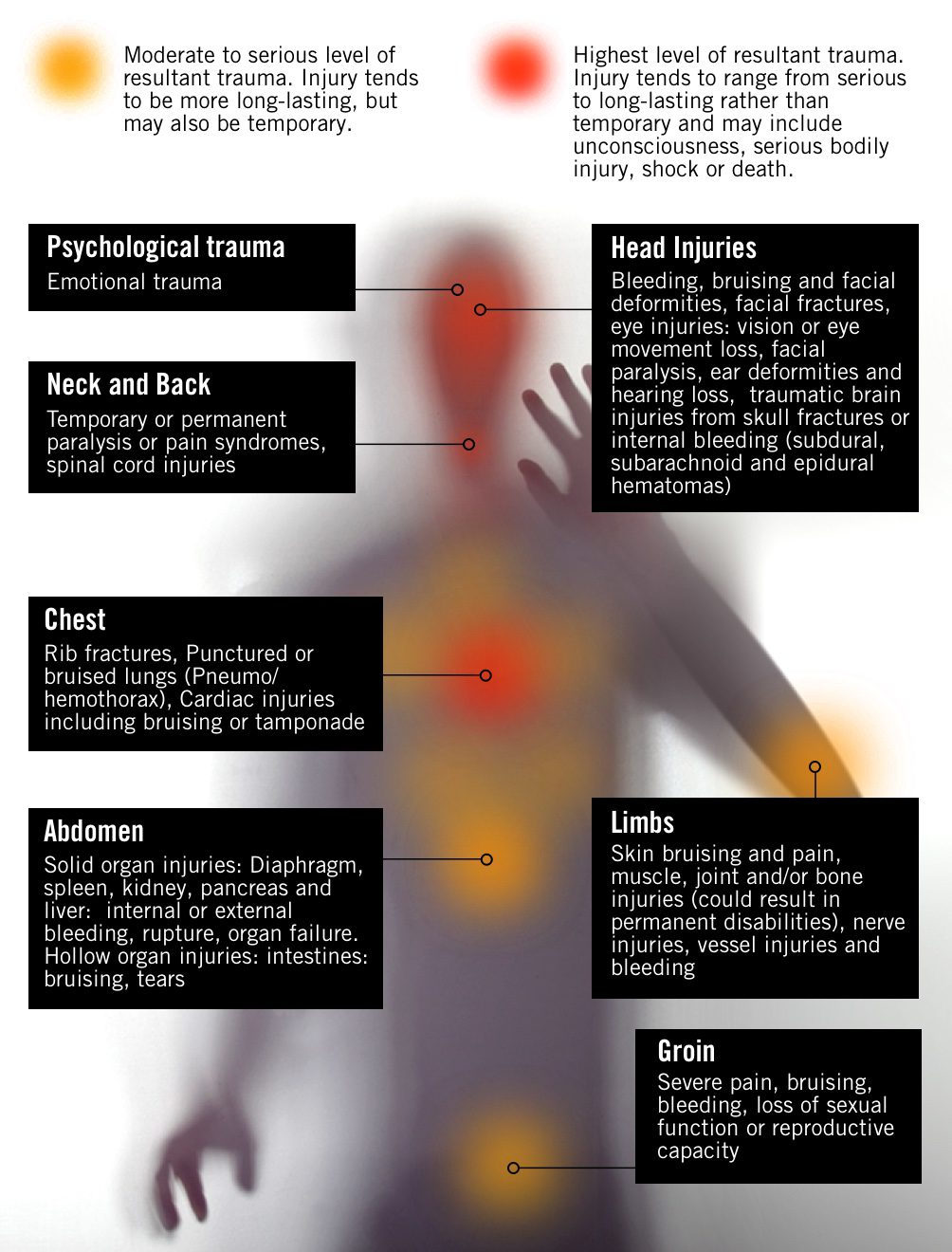TABLE OF CONTENTS
Introduction
Time and again, law enforcement officials are too quick to resort to the use of force, often against peaceful protesters exercising their rights to freedom of peaceful assembly.
In recent years and throughout the Covid-19 pandemic, states have restricted the rights to freedom of peaceful assembly and freedom of expression, often violently. Civic space is shrinking. Among the most frequently used and misused weapons in this context are police batons in different forms and sizes.
Amnesty International has investigated the misuse of batons and other striking weapons, analysing illustrative incidents spanning the past decade from around the world. Examining hundreds of photos and videos, researchers have verified 188 incidents of the misuse of striking weapons including police batons, lathis (long sticks), sjamboks (rigid whips) and improvised weapons in 35 countries, covering all regions of the globe. These include examples from violent crackdowns of mass protests in countries as diverse as Belarus, Colombia, France, India and Myanmar.
Why Amnesty is campaigning to regulate the torture trade
Batons have been used to inflict beatings as a means of punishment, beat people who are already restrained, deliver unjustified dangerous head and neck strikes, and choke people in neck holds. Single baton blows have been delivered with such force that the victims have collapsed to the ground. Incidents documented also include batons being used to commit sexual violence.
Amnesty International’s Crisis Evidence Lab and Digital Verification Corps, based at six global universities, analysed more than 500 photographs and videos, identifying and verifying the final 188 illustrative incidents showing instances of security forces using striking weapons and other less lethal weapons and equipment in a manner that amounts to torture or other ill-treatment.
Less lethal weapons and equipment are intended to allow law enforcement officials to use the minimum level of force according to circumstances and avoid using lethal force. Some less lethal weapons and equipment can have a legitimate use in law enforcement if employed correctly and in line with international standards for law enforcement. Yet such equipment can have unintended dangerous and even lethal effects if not used in compliance with human rights standards and is also open to abuse.
Amnesty International has documented its misuse in all regions of the world – in many instances against protesters exercising their right to freedom of peaceful assembly.
Health implications of baton strikes
Baton injuries can range from characteristic abrasions, bleeding and bruising to more severe injuries including bone fractures, nerve/muscle damage and internal injuries that may result in permanent disability or death. Injury patterns and severity are dependent on the location of the strike, the amount force used, and the type of baton.
Police forces across the world are equipped with a range of less lethal equipment – such as tear gas and pepper spray, batons, plastic and rubber bullets, and water cannon – which is regularly deployed in the policing of public protest.
For decades, Amnesty International has been documenting how these weapons are used to abuse human rights. In June 2020, Amnesty launched a major investigation into the misuse of tear gas, documenting abuse in 22 countries and territories. Blunt Force focuses on striking weapons, such as police batons, which are widely misused across the world.
This equipment is the simplest – and commonest – type of less lethal weapon. Striking weapons come in many shapes and sizes and different materials. They include not just police batons and sticks, but also whips, which are inherently abusive. Striking weapons are routinely used in intimidatory, aggressive acts of force leading to physical and psychological trauma.
Batons are currently traded with no regulation. There is an emerging opportunity to create a global, legally binding instrument at the UN that prohibits the trade in inherently abusive equipment and places strict human rights-based trade controls on other equipment, like batons – which can serve a legitimate function, but that as our research shows, can also be used for acts of cruel, inhuman and degrading treatment, and even torture.
Use of force standards
To fulfil their responsibilities of maintaining law, safety and public order and preventing and detecting crime, law enforcement officials are granted a number of powers, including the power to use force and firearms.
These powers come with obligations and responsibilities, particularly regarding a range of human rights that may be affected by these powers and which the state and its agents are obliged to respect and protect.
Law enforcement officials face a wide variety of situations, sometimes requiring instantaneous decisions, often in highly stressful and even dangerous circumstances. The use of force must only be resorted to with the utmost respect for the law and with due consideration for the serious impact it can have on a range of human rights: the right to life, to physical and mental integrity, to human dignity, to peaceful assembly, and to freedom of movement – to name just the ones most frequently affected. Four guiding principles (legality, necessity, proportionality, and accountability) must govern any state action that impacts on the human rights of a person. Any use of police powers by law enforcement officials must comply with these principles; for example, when carrying out an arrest or a stop-and-search activity or when using force against an individual, or group of individuals.
Although punishment is never a legitimate objective for a law enforcement action, such practices are regularly reported in the policing of public assemblies, and batons are one of the weapons most frequently used for this purpose. Over the last two years, Amnesty International has reported on many instances in which law enforcement officials have used batons to punish people for violating COVID-19 restrictions. This is clearly unlawful, as punishment is never a legitimate objective for a law enforcement action.
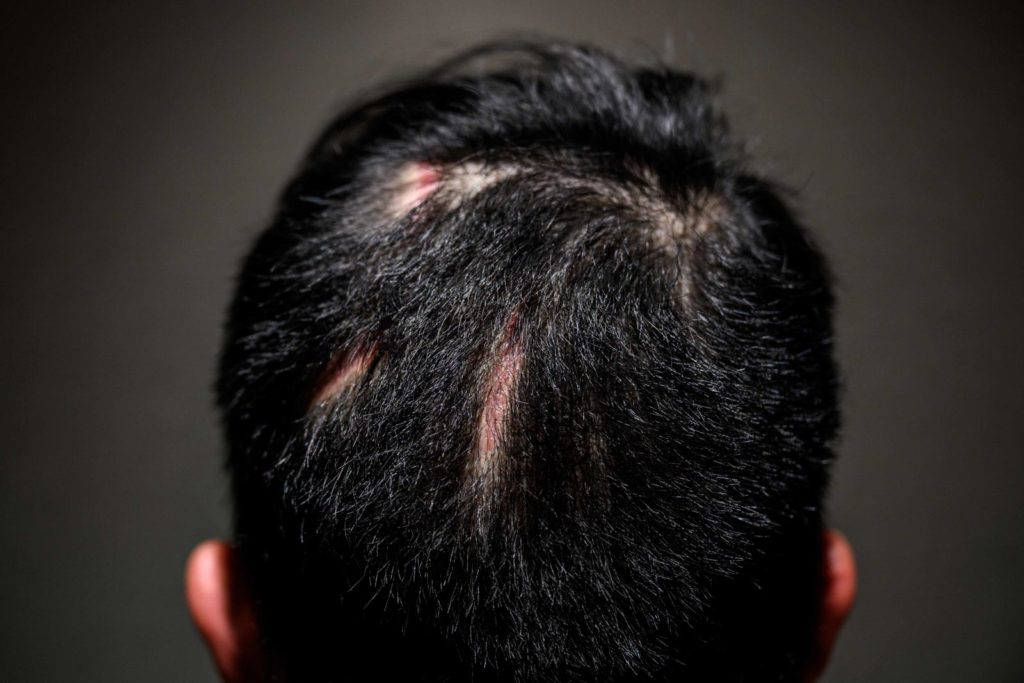
Necessity means using only the force actually needed to achieve an objective, and attempting first to use non-violent means first, whenever this is feasible. Verbal commands, negotiation, peaceful settlement of conflict, warnings, or simply keeping a safe distance – all these are ways to achieve an objective without resorting to the use of force. It is crucial that law enforcement officials are well trained in all these options in order to enable them to minimize any harm they might cause.
Police are often observed resorting to the easiest, rather than the least harmful means. When they have a weapon at hand, such as a baton, it is often this weapon they will use. When dispersing protesters, police frequently carry out so-called baton charges. Here, lines of police run at crowds with raised batons, chasing after protestors and beating them in order to make them disperse – even though police have other options beyond potentially inflicting considerable injury by means of a baton. Verbal commands, simple pushes or carrying people away are actions that will cause much less harm than hitting someone with a baton.
Law enforcement objectives are not supposed to be achieved at all costs. Any harm police might cause must not outweigh the harm they want to prevent. When a person is only passively resisting but not acting violently, using force that is likely to cause any more than negligeable injury would be disproportionate. Even when police are facing violent individuals, putting the life of such individuals at risk is only permissible if the life of another person is at stake. Baton use can result in considerable injuries, including life threatening ones. There are many very harmful ways of using a baton. Hitting the head or the neck, jabbing someone with the baton, using it as a neck hold – all these are life threatening baton uses.
Even when accompanied by adequate instructions and training, law enforcement equipment is often misused, sometimes in an abusive, unlawful way. This can amount to excessive use of force, in some instances violating the prohibition on torture and other cruel, inhuman, or degrading treatment.
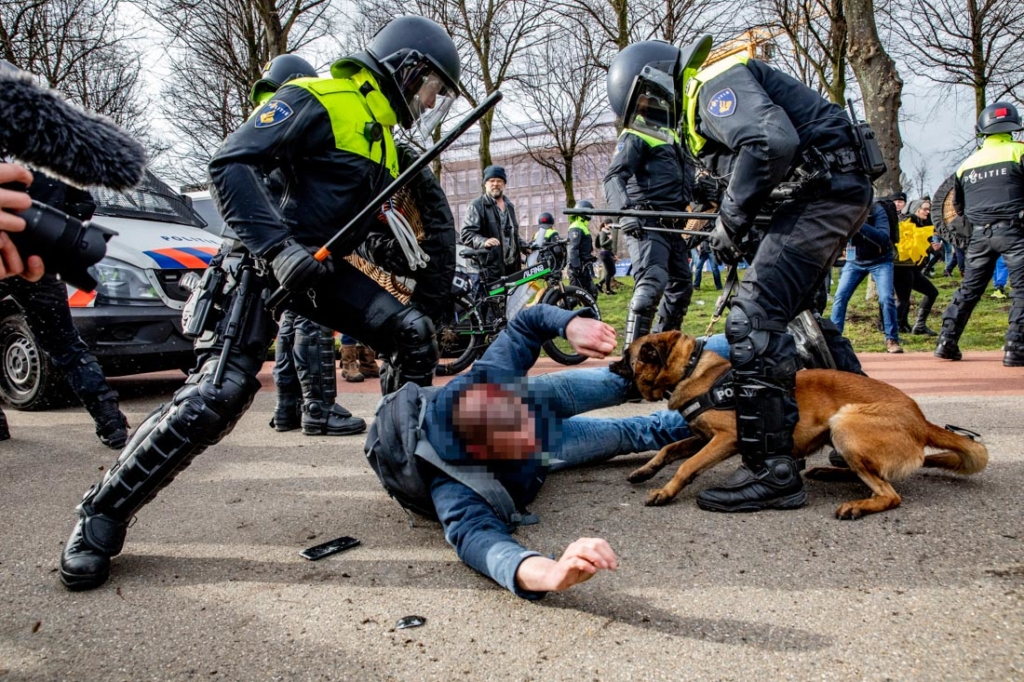
Nobody is above the law, especially those who have a duty to uphold it
Dr Anja Bienert, Amnesty International Netherlands
Right to protest
The rights to freedom of peaceful assembly, expression and association are enshrined in international law. States are under an obligation to facilitate the right to freedom of peaceful assembly, actively encouraging people to engage in assemblies.
States must respect, protect, and fulfil the right to peaceful assembly without discrimination of any kind. Peaceful assemblies should be protected, and they do not lose their peaceful character if there are isolated acts of violence or unlawful behaviour by some individuals.
The exercise of this right should not be dependent on the authorisation of the state; states may request notice (although not for spontaneous assemblies) – but not authorisation.
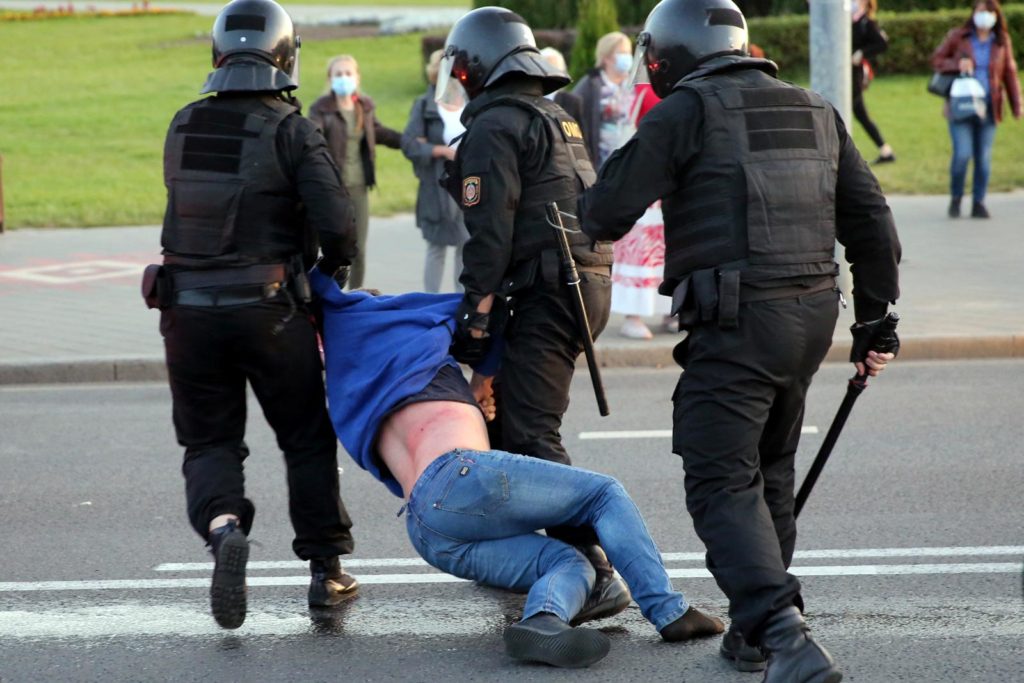
Policing of assemblies
In the handling of public assemblies, it is the primary responsibility of the police to facilitate and protect the exercise of the right to freedom of peaceful assembly. When fulfilling this duty, police are supposed to take all reasonable and appropriate measures to enable people to exercise this right without undue interference and without intimidating those who wish to participate in the assembly. In doing so, they should always act in an impartial manner. When having to balance different interests at stake, police should give due consideration to the importance of the right to freedom of peaceful assembly. A policing approach that displays a heavy handed, zero-tolerance attitude with excessively robust interventions from the outset may contribute to increased tension and provoke hostility or aggressive reactions, leading to the overall escalation of a situation.
Amnesty International believes it is the duty of law enforcement agencies to facilitate the holding of peaceful assemblies and avoid approaches that might be perceived as measures to intimidate or harass people wishing to enjoy their right to freedom of peaceful assembly. Zero-tolerance approaches are generally counterproductive, risk worsening a potentially tense situation, and have a chilling effect on those who wish to assemble peacefully. The approach of law enforcement agencies in the policing of assemblies should be driven by communication, negotiation and mediation, seeking a peaceful settlement to conflicts with the overall aim of ensuring that an assembly is held smoothly.
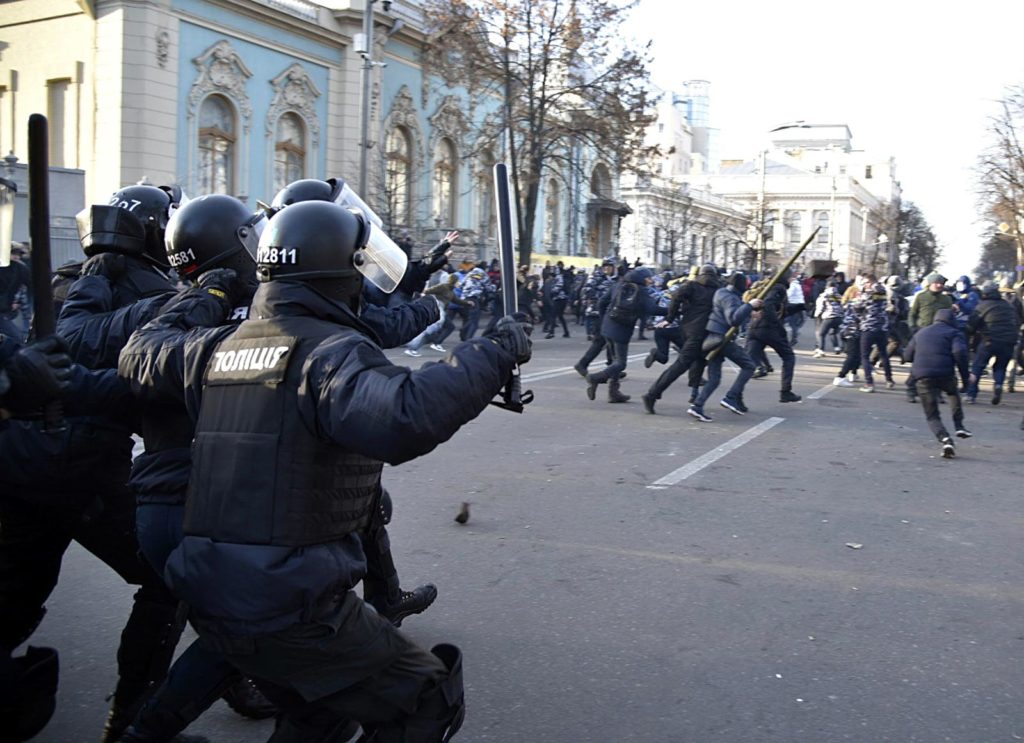
What are batons?
Description
Batons are a type of hand-held kinetic impact weapon (also known as ‘striking weapons’). They are usually made of rubber, plastic, wood, or metal, and can range in size from approximately 20 centimetres to two metres in length. There are three main types of batons:
- straight baton,
- side-handle baton (or ‘tonfa’), a straight baton with an added handle on one side,
- extendable or telescopic baton, a baton that can extend up to two or three times its retracted length.
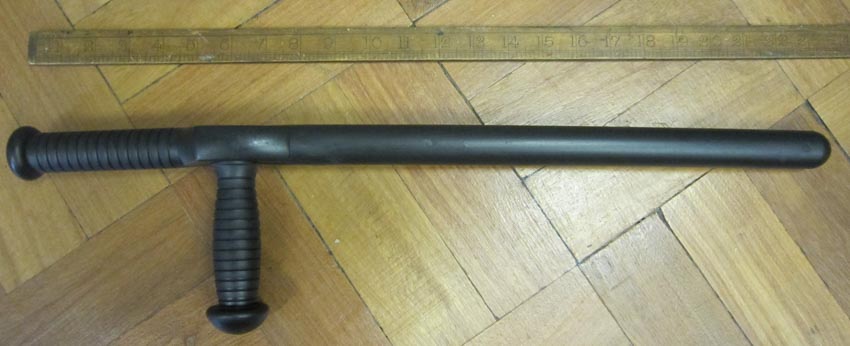
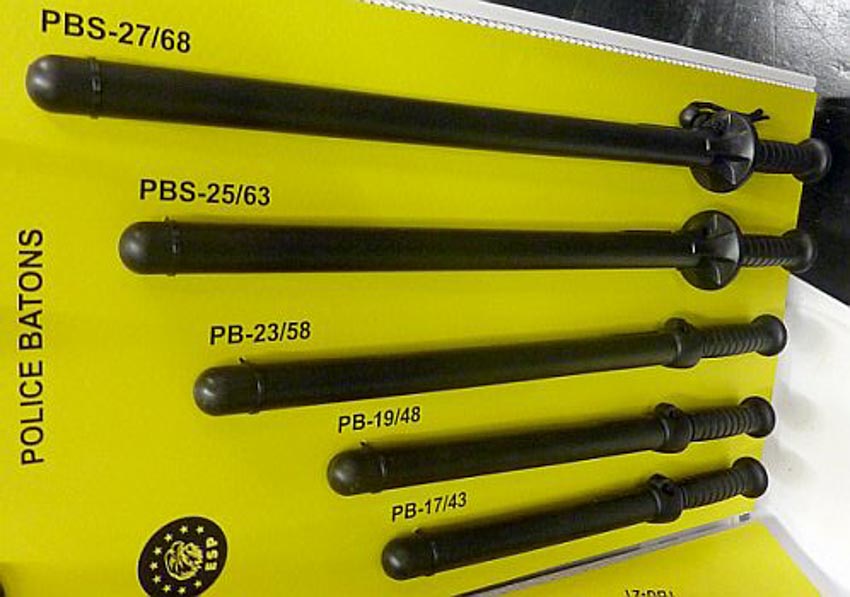
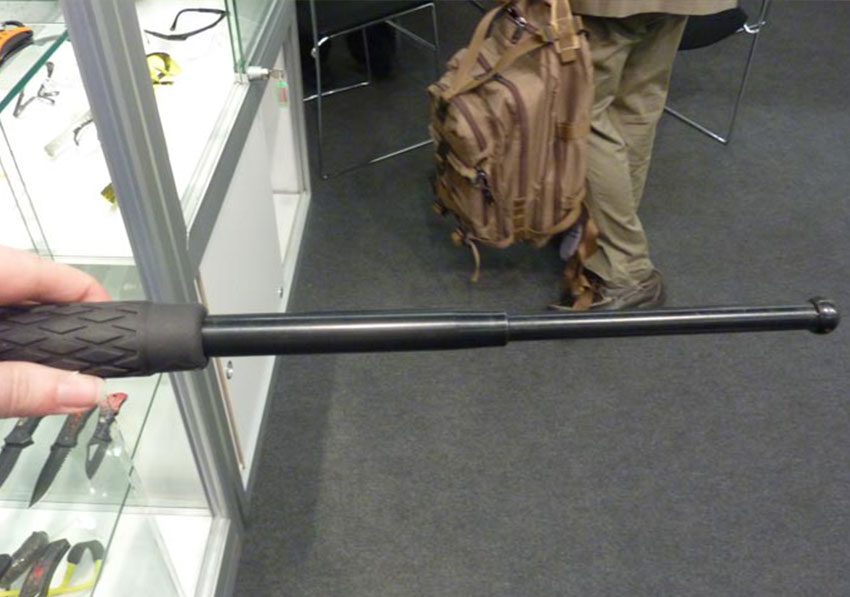
Intended purpose
Batons are most commonly used to threaten or strike a person, causing physical pain to force the person to either comply or be deterred from an action. They can also be used defensively by law enforcement officials, including, for example, to protect officials from blows from violent individuals.
Possible health/human rights implications of use in policing
Batons are often misused by law enforcement officials to inflict unnecessary or excessive force through, for example, beating, pushing, or jabbing, which may cause internal injuries or bleeding. Overarm strikes and strikes to the head or other sensitive areas of the body increase the risk of serious injury or death. Batons can be used to lever, apply force to, or crush body parts. Batons are also known to have been misused as a tool of rape or to apply dangerous restraint techniques, particularly neck-holds that may restrict breathing.
As a rule, batons should be used in a way that does not cause considerable injury, and therefore should be aimed at larger muscles parts such the thighs. Anything more than a single baton strike may amount to excessive use of force. Law enforcement officials must assess (and be able to justify) the need for each single baton strike, something that can only be ensured through continuous training and rigorous certification processes. Repeated baton strikes are likely to be punitive and amount to excessive use of force or even torture or other ill-treatment. Law enforcement officials must be held accountable for any misuse of batons and other forms of force and this requires close supervision and accountability structures. The use of batons in a way that is likely to cause considerable injury and excessive pain, such as strikes to the knees, elbows, wrists and groin areas must be avoided, unless the threat the person presents is at least equally serious and cannot be countered by less harmful use of the baton (or other means). Batons should not be used in a way that bears the inherent risk of serious, potentially life-threatening injury, such as strikes to the head or neck, or by resorting to a neck hold. Such use should, as a rule, be prohibited. Only situations where another life is at risk may justify an exception to this rule, provided there is no less dangerous way of stopping the threat. As with other ways of using force, batons may never be used for the purpose of punishment.
What are lathis?
Description
A cane or stick usually made from bamboo or other wood. The length, width, weight, and flexibility can vary.
Intended purpose
Use of lathis appears to be restricted to certain countries, notably in South Asia, where they are commonly employed in the policing of public gatherings. Lathis have associations with a history of degrading repressive violence under colonial rule. Like other striking weapons, lathis are used to enforce compliance through pain or the threat of pain and are frequently misused to administer beatings.
Possible health/human rights implications of use in policing
Lathis are often misused by law enforcement officials to inflict unnecessary or excessive force through, for example, heavy or sustained beatings including to sensitive parts of the body. In comparison to standard batons, the potential of lathis to split or splinter may increase the likelihood of injuries to those targeted. The human rights implications of baton use in policing discussed above is equally applicable to lathis.
What are sjamboks?
Description
Sjamboks are a type of heavy and strengthened whip, traditionally made from leather, but now also from plastic. Historically used in parts of Southern Africa for cattle droving, they have been employed in certain countries in law enforcement.
Intended purpose
Whips, including sjamboks, are used to carry out corporal punishment. In addition, sjamboks are sometimes used as a striking weapon in policing public gatherings.
All whips, including sjamboks, are inherently abusive and fulfil no legitimate law enforcement purpose.
Possible health/human rights implications of use in policing
The use of whips such as sjamboks may lead to severe physical pain, mental suffering, and serious injury, including lacerations. It lies in the very nature of these weapons that they are often used for inflicting punishment, including torture or other ill-treatment.
It is difficult to imagine a way of legitimately using sjamboks or other whips for law enforcement purposes. Given their inherently abusive character they should be prohibited in policing.
What are improvised striking weapons?
Description
In addition to specially manufactured hand-held kinetic impact law enforcement equipment, items such as bats, clubs, metal bars, and rifle butts are sometimes used as ad hoc striking weapons.
Intended purpose
Ad hoc striking weapons are frequently used for unlawful purposes. Officials should only ever use specially designed and tested human rights-compliant weapons and equipment. Police officials must be instructed / required to use equipment and weapons officially assigned to them for the purpose for which it was designed. As a rule, they should not resort to anything else.
Possible health/human rights implications of use in policing
Law enforcement officials should be equipped with a range of different weapons and equipment, providing officials with various force options. All weapons and equipment intended to be used by law enforcement should be subject to standardised legal review, testing, and procurement procedures, to ensure that they are safe to use and do not violate international human rights law. No such procedures occur for ad hoc weapons, and the risks inherent in their use are therefore unknown but can potentially be grave and life-threatening.
The Path to Global Controls on the Tools of Torture
The following timeline summarises the milestones along the path to establishing global controls on the trade in equipment that can be used for torture, other ill-treatment and carrying out the death penalty.
Case studies
Striking weapons, such as simple batons, are the most common less lethal weapon used by police forces around the world. Batons can be used legitimately for self-defence or defence of others against violent individuals or against individuals violently resisting lawful arrest. Yet, as these case studies show, they are also often used on persons already under control and / or to punish by inflicting pain and suffering. In some cases this amounts to torture or other ill-treatment. Other striking weapons, such as the sjambok (a type of stiff whip), cause unnecessary pain and injury, are inherently abusive, and should never be used for law enforcement; their manufacture, trade or promotion should be prohibited when intended for law enforcement purposes.
Case study 1
Violation type
Unjustified and dangerous head or neck strikes
Location
Hong Kong
Date
September 2019
Description
A young male protester in Hong Kong is repeatedly hit with batons by several law enforcement officers in full riot gear in a Mass Transit Railway (MTR) station. One of the security officers strikes him on the head. He is then restrained on the ground while the officers arrest him. Bleeding is visible from the side of the head where he was struck.
Amnesty International’s analysis
- Strikes to the head are dangerous; other options were available to the officers which would not cause such significant injuries. The injuries caused by strikes to the head outweigh the law enforcement purpose of restraining a person.
- Where officers are punitively using force that causes severe pain or suffering this will amount to torture.
Case study 2
Violation type
Excessive use of force
Location
Colombia
Date
April 2021
Description
At least five policemen surround a protester in Colombia, pinning them into a corner outside a branch of Bancolombia bank. One of the officers then takes up their baton and starts striking the protester. No officers intervene to stop the beating. The police officer strikes them with a baton several times, shortly after another officer kicks him.
Amnesty International’s analysis
- There are extremely limited situations in which the authorities can legitimately use batons at an assembly. In practice, they can only be used in response to violence or a threat of imminent violence.
- Baton strikes to the head or neck carry an inherent risk of serious injury.
- The use of force was unnecessary and disproportionate to the threat faced and so is a violation of international human rights law.
Case study 3
Violation type
Strikes while target was restrained
Location
Belarus
Date
December 2020
Description
Three riot police are leading a protester down some stairs. An officer strikes the protester on the back of the legs even though he is not resisting the arrest. While held by one officer, the protester is struck on the back of the head with a baton and punched in the face and stomach.
Amnesty International’s analysis
- Baton strikes while a subject is under control are unnecessary and disproportionate.
- This means the strikes were administered punitively, amounting to torture or other cruel, inhuman or degrading treatment or punishment. This is a human rights violation.
Case study 4
Violation type
Rape/Sexual assault
Location
France
Date
May 2019
Description
Several police officers surround a protester lying on the ground. The protester is being uncooperative with the offices. At one point an officer puts the baton inside the back of the protester’s trousers.
Amnesty International’s analysis
- Sexual assault with batons amounts to torture or other cruel, inhuman and degrading treatment. It is unlawful and a human rights violation.
Case study 5
Violation type
Beatings as a means of punishment
Location
Myanmar
Date
March 2021
Description
CCTV footage captured during post-coup protests in Myanmar shows a police officer removing what appear to be medical workers from an ambulance. He makes them kneel and then proceeds to beat them with the butt of his rifle. Later in the sequence, more officers appear who then continue to strike the medical workers with batons.
Amnesty International’s analysis
- Beatings, with batons or ad hoc striking weapons such as rifle butts, as means of punishment constitute torture or other cruel, inhuman and degrading treatment or punishment. Repeatedly striking a person’s head or neck with a baton is inherently dangerous. Likewise, repeated strikes with rifle butts can result in serious injury. This is a human rights violation.
The producers/trade
The trade in law enforcement equipment and weapons is international, with many companies promoting and supplying their products to law enforcement bodies within their own countries and to customers worldwide. While global marketing is conducted via the internet, the Omega Research Foundation has documented a large number of specialised arms and security equipment trade fairs and exhibitions. These are held regularly in at least 36 countries, mostly on an annual or biennial basis, in many instances facilitated and supported by the host state. Standard law enforcement equipment, including batons, is regularly promoted at these fairs, but Amnesty International and Omega have also uncovered the promotion of inherently abusive striking weapons such as spiked batons at a number of these events.
Companies also have a responsibility to respect human rights
Under the UN Guiding Principles on Business and Human Rights all companies have a responsibility to respect human rights. While trade controls relate to state human rights obligations, this does not exempt companies from carrying out their own human rights due diligence to ensure their goods and services are not linked to human rights harms.
Companies that manufacture, promote or trade in law enforcement equipment must assess and address human rights risks and abuses arising in all aspects of their business, including how clients such as police forces use their weaponry and related services. They should refrain from exporting equipment to forces which routinely abuse it, irrespective of whether they are licensed to export such equipment by their home state. Companies that manufacture, promote or trade in inherently cruel, inhuman or degrading law enforcement equipment and weapons must immediately stop these activities.
Expert voices
Simon Crowther – Legal Advisor, Amnesty International
Anja Bienert – Policing and Human Rights Expert, Amnesty International
Michael Crowley – Research Associate, Omega Research Foundation
Mitch Paquette – Advisor, Crisis Evidence Lab, Amnesty International
Recommendation 1
Police use of equipment and standards
Amnesty International is calling on law enforcement officials to:
- Fully respect and conform to the UN Basic Principles on the Use of Force and Firearms by Law Enforcement Officials when resorting to the use of force, including batons.
- Facilitate the exercise of the right to freedom of peaceful assembly by avoiding the use of force. Where strictly necessary for maintaining peace and order and protecting human rights, law enforcement offices should use only the minimum force necessary.
- Use batons and similar striking weapons as sparingly as possible and only against violent individuals posing significant risks to themselves or others.
- Use batons, as a rule, in a way that does not cause considerable injury. Batons therefore should only be aimed at larger muscles parts such the thighs.
- Avoid the use of batons in a way that is likely to cause considerable injury and excessive pain, such as strikes to the knees, elbows, wrists and groin areas, unless the threat the person presents is at least equally serious and cannot be countered by less harmful use of the baton (or other means).
- Do not use batons in a way that bears the inherent risk of serious, potentially life-threatening injury, such as strikes to the head or neck, or resorting to neck holds. Such use should, as a rule, be prohibited. Only situations where another life is at risk may justify an exception to this rule, provided there is no less dangerous way of stopping the threat.
Amnesty International is calling on states to:
- Ensure that law enforcement officials are properly trained in the policing of assemblies in a human-rights-compliant manner, enabling them to fulfil their duty to facilitate the enjoyment of the right to freedom of peaceful assembly, including through adequate policy, training and demonstrated respect for human rights.
Recommendation 2
Torture Trade standard setting
Current efforts to place global controls on the trade in law enforcement equipment and weapons used for torture and other ill-treatment must include the broadest scope of less lethal equipment and weapons possible – particularly those types most regularly abused such as batons.
Amnesty International is calling on states to:
- Introduce regulations or strengthen existing national measures on the trade, which:
- Halt all transfers of inherently abusive law enforcement equipment and weapons.
- Control transfers of law enforcement equipment and weapons to prevent their acquisition by law enforcement agencies likely to misuse them for torture and other ill-treatment
- Support the development of regional and international instruments in this area, including through the current UN process.
- Support arguments for the broadest possible scope of law enforcement equipment and weapons to be included in international regulation and for this regulation to be legally binding on all states
Recommendation 3
The responsibility of companies
Companies have a responsibility to respect human rights. This obligation is clearly defined in international standards such as the UN Guiding Principles on Business and Human Rights (UN Guiding Principles) and the Organisation for Economic Co-operation and Development (OECD) Guidelines for Multinational Enterprises. Companies involved in the manufacture of law enforcement equipment have the same human rights obligations as businesses operating in other sectors.
Amnesty International is calling on companies to:
- Undertake human rights due diligence to identify, prevent, mitigate and account for the potential and actual human rights impacts of their products and services.
- End the manufacture, promotion and trade in inherently abusive equipment.
- Increase transparency around the trade and manufacture of law enforcement equipment by publicly reporting on transfers and identified issues.
Recommendation 4
Accountability
Amnesty International is calling for state authorities to:
- Ensure that incidents in which law enforcement use force are adequately recorded and scrutinised to determine whether they amount to human rights violations.
- Ensure that all incidents of human rights violations perpetrated by law enforcement agencies are thoroughly, effectively and independently investigated, and where warranted suspected perpetrators are brought to justice in fair trials without recourse to the death penalty.
- Put in place effective mechanisms to provide for adequate reparations for victims of such violations
Take action
STOP THE UNLAWFUL USE OF POLICE BATONS
Around the world, governments are cracking down on protests by misusing police batons. These weapons are being misused as a tool for repression. It is time to end the human rights violations committed with police batons. Take action and call for regulation now.
Our research shows that batons are misused to beat people as a form of punishment. They are used to strike people when restrained. They are used to deliver unjustified dangerous blows to the head and neck. They are used to commit sexual violence. They are used to inflict torture. All of this must stop.
Batons are considered a less lethal weapon intended to allow law enforcement officials to avoid having to use more harmful weapons, but our research shows that they are frequently misused, often to punitively cause harm in violation of international law. Despite this, the trade in batons is unregulated. It is time to end the torture trade and demand regulation.
Sign the petition and call on your government to:
- Effectively and robustly implement the UN Basic principles on the use of force and firearms.
- Investigate and prosecute any unlawful use of batons by law enforcement and security forces. Including but not limited to the following conditions:
- Strikes on individuals who are already restrained.
- Commission of sexual assault and rape.
- Beatings as a form of punishment.
- Unjustified and dangerous strikes to the head and neck.
- Support the negotiation of an international instrument to end the torture trade.


